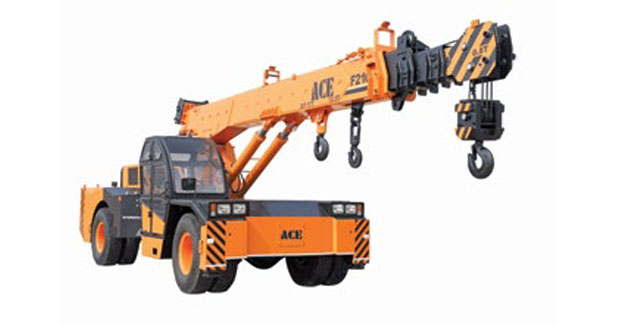
On A moderate growth
Pick-and-carry crane is a product that is unique to India. It has a rigid (as opposed to a revolving) superstructure, and is essentially a material handler that is used on a wide variety of light lifting tasks which in other countries would probably be done by an industrial crane or a telescopic handler. The popular models' rated capacity is typically less than 18 tonne, although cranes of up to 23 tonne are also currently available.
Within pick-and-carry cranes, two distinct segments have evolved in the last few years. First is the traditional type, popularly known as the 'Hydra' crane. These cranes are mainly used by a wide variety of customers for general handling at construction sites, steel plant erection, timber handling, and material handling in industrial yards and shipyards and later some of them are used for maintenance work after the project is complete.
In India, Action Construction Equipment (ACE) leads the pick-and-carry crane market with Escorts being the second largest manufacturer, followed by Indofarm, Standard and others.
Product evolution
Within pick-and-carry cranes, two distinct segments have evolved in the last few years. First is the traditional type, popularly known as the 'Hydra' crane. These cranes are mainly used by a wide variety of customers for general handling on construction sites, steel plant erection, timber handling, and material handling in industrial yards and shipyards, and later some of them are used for maintenance work after the project is complete.
The second is the advanced version that has a front-mounted cabin, faster travel speed, steering wheel, and better safety and stability due to the lower centre of gravity. Many projects, including metro rail, are discouraging the 'Hydra' versions on safety grounds, and as a result, the more advanced versions of pick-and-carry cranes are gaining popularity.
Market trends
Pick-and-carry cranes dominate sales of mobile cranes in the country and have traditionally accounted for 93-96 per cent of the market. Their share fell to 91 per cent in 2015 but recovered to 94 per cent in 2016. The pick-and-carry crane market declined steadily from a peak of 10,589 units in 2011 to 4,412 units in 2015, but recovered by 17 per cent in 2016 to 5,171 units.
Opportunities
The end-users of pick-and-carry cranes can be classified into three major categories: rentals, construction companies/contractors, and industry and the government. It is estimated that over 50 per cent of cranes are bought by rental companies for use in construction as well as industrial applications, 40 per cent by construction companies and contractors, and balance by government bodies.
Infrastructure development is a key economic driver and enjoys an intense government focus that should spur the demand for construction equipment in the country. In the current budget, the government has increased the total allocation in the infrastructure sector by over 10 per cent from Rs 3,586.34 billion in 2016 to Rs 3,961.35 billion in 2017. It is monitoring all the infrastructure projects at the highest level and hindrances are being removed through continuous initiatives to reform procedures and policies such as real estate regulatory bill, faster environment and forest clearances.
The government is also is keen on improving the ease of doing business and is focusing on 'Make in India' programme for economic growth. Its efforts seem to be bearing fruit with IIP growing 5 per cent in the financial year ended March 2017. This growth in industrial activity bodes well for the growth in demand for pick-and-carry cranes, especially in the rental sector.
Outlook
Pick-and-carry cranes are expected to remain popular for construction and industrial applications in view of lower price, however, the segment would witness only a moderate growth in the future. Sales are forecast to increase to 5,600 units in 2017 and grow to 6,500 units by 2021.
The author is General Manager, India, Off-Highway Research


 +91-22-24193000
+91-22-24193000 Subscriber@ASAPPinfoGlobal.com
Subscriber@ASAPPinfoGlobal.com